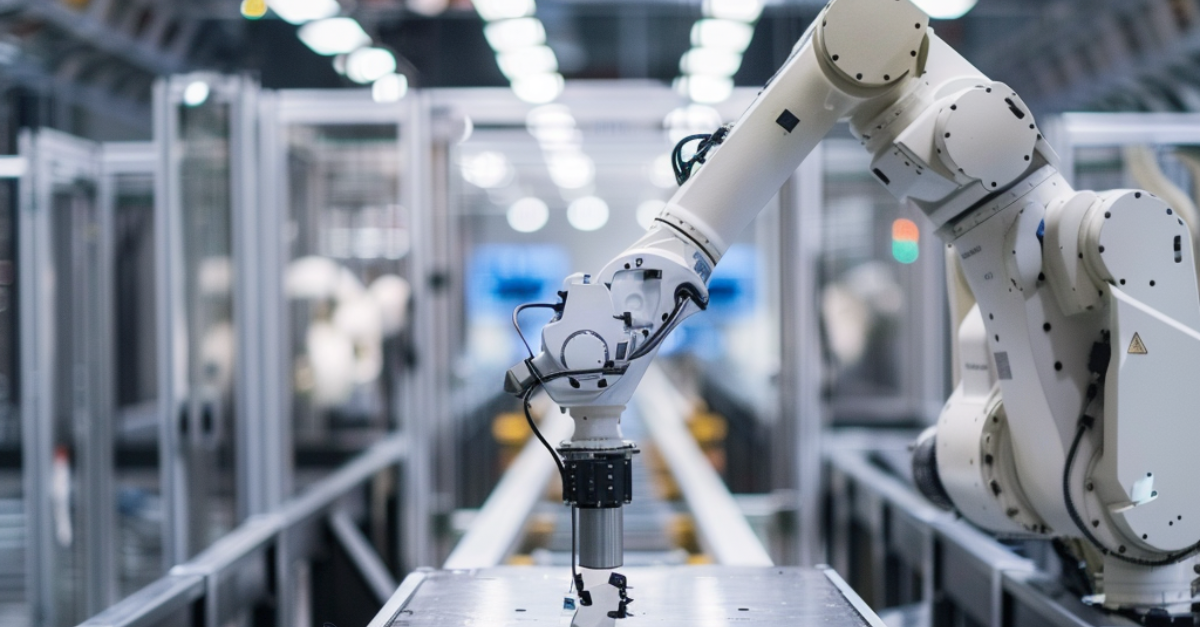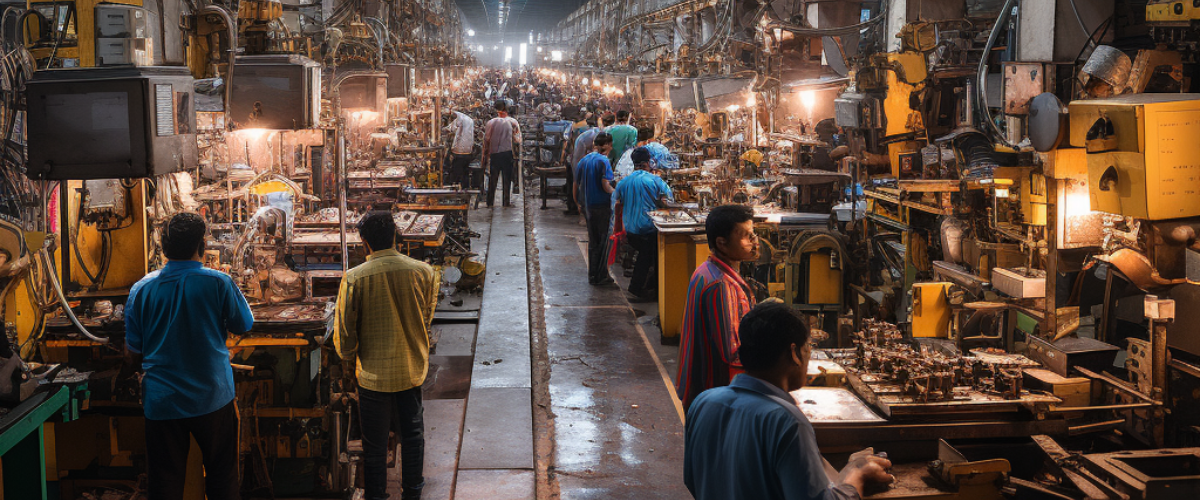The Impact of FOREIGN DIRECT INVESTMENT (FDI) on India's Manufacturing Sector
Did you know, in recent years, India has undergone a remarkable surge in foreign investment and manufacturing, solidifying its position as a dynamic player in the global economic landscape. This transformative shift can be attributed to the government's significant initiative, "Make in India," launched in 2014. Functioning as a catalyst, this initiative has streamlined business processes and actively encouraged international companies to establish their foothold in the country. The results are evident in the impressive increase in foreign direct investment (FDI), with India attracting a record $83.57 billion in FDI during 2021-22—a substantial leap from $60.22 billion in 2016-17. Notably, the manufacturing sector led the way, drawing in $27.38 billion in FDI during the same period.
This surge in FDI can be attributed to India's liberalised FDI policies and simplified compliance procedures, collectively making the country an increasingly attractive investment destination. The announcement of Tesla's decision to establish a plant in Gujarat is just one notable example, indicative of a larger trend. Other international giants such as Samsung, Apple, Foxxcon, and Japanese automakers have also chosen to initiate manufacturing operations in India—a topic we delve deeper into in this blog.
The proliferation of manufacturing plants and foreign direct investment has not only bolstered economic growth but has also had a profound impact on digital initiatives in the country. In this blog, we will delve into this transformative phase, examining major foreign investments in India and their consequential influence on India's journey towards emerging as a global manufacturing powerhouse.
Tesla's Entry into the Indian Market: A Game-Changing Milestone
A standout example of this surge is Tesla's recent entry into the Indian market. The electric vehicle (EV) giant, led by visionary entrepreneur Elon Musk, has established a manufacturing plant in Gujarat, marking a significant milestone for both the automotive industry and India's manufacturing landscape. Tesla's decision underscores India's potential and the growing demand for sustainable mobility solutions.
This move assumes paramount importance in the context of the global shift towards electric vehicles and sustainable transportation. Tesla's presence in India not only augments the EV infrastructure but also creates job opportunities and stimulates innovation in the clean energy sector. It is poised to contribute significantly to India's aspiration to become a manufacturing and export hub for electric vehicles.
Investment from Other Global Players: A Diverse Tapestry of Opportunities
While Tesla commands attention, it is not the sole player recognizing India's potential. Several international companies are increasing their investments and manufacturing activities across various sectors.
1. Taiwan's Foxconn: Pioneering a $100 Billion Revolution
Foxconn, a renowned global leader in the electronics manufacturing sector, has made an historic commitment by vowing to invest a remarkable $100 billion in India. Since 2005, Foxconn has continuously channelled investments into India, establishing nine production campuses and more than 30 factories within the nation. In 2023, Foxconn unveiled its intentions to double down on its investments in India, with a primary focus on the production of semiconductors and advanced technological products. This substantial commitment aims to create cutting-edge manufacturing facilities, positioning India as a pivotal participant in the worldwide electronic device supply chain.
- The specific technologies that Foxconn is planning to introduce in India encompass:
- Establishing a $20 billion semiconductor manufacturing facility to initiate the production of applications such as smartphones, computers, and automotive electronics.
- Collaborating with Tata Motors and allocating $1 billion for a new electric vehicle manufacturing facility in Maharashtra.
- Expanding their operations in the manufacturing of displays within India.
- Sustaining their investment plan in various technology sectors, including artificial intelligence, robotics, and 5G.
2. South Korea's Samsung: $5 Billion Infusion
Samsung, with investments in India dating back to 1995 that have surpassed $5 billion, has been placing a strong focus on manufacturing smartphones and various electronic devices within the country. This strategic choice aligns with India's goals for self-reliance and technological advancement.
The specific technologies that Samsung intends to introduce in India include:
- Allocating $3 billion for the construction of a new semiconductor manufacturing facility in Noida, Uttar Pradesh.
- Expanding display manufacturing operations with a $1 billion investment, with the support of the Indian government.
- Investing $1 billion in establishing a research and development centre.
- Pioneering advancements in technologies such as artificial intelligence, robotics, and 5G.
- Increasing investments in smart manufacturing capabilities to initiate laptop production, enhancing competitiveness and efficiency.
- Demonstrating a strong commitment to research and development through collaborations with Indian startups and universities, with plans to hire approximately 1,000 engineers for its R&D institutes across India in 2023.
- Promoting 5G technology for innovative applications in areas like healthcare, education, agriculture, and manufacturing.
- Heavily investing in AI-powered solutions across various industries in India, including the development of new medical diagnostic tools, enhanced agricultural production efficiency, and innovative educational experiences.
- Utilising the Internet of Things (IoT) to create smart city solutions, optimise manufacturing operations, and introduce novel consumer experiences.
- Fostering semiconductor manufacturing to boost India's electronics industry and generate new employment opportunities.
3. US-based Apple: Navigating Towards Domestic Manufacturing
Since 2017, Apple has been engaged in manufacturing its products within India, and it has established relationships with over 50 suppliers in the nation. In 2023, Apple unveiled its intentions to invest $40 billion in India within the next five years, with a primary emphasis on expanding its manufacturing operations. This potential endeavour underscores Apple's acknowledgment of India as a crucial market and manufacturing center.
The specific technologies that Apple is aiming to introduce in India encompass:
- Expanding iPhone manufacturing operations within India.
- Initiating the establishment of new plants for manufacturing iPad and MacBook products.
- Commencing the production of components within India to enhance camera modules and batteries, thus directly impacting sector growth.
- Swiftly adopting technologies such as artificial intelligence, robotics, and 5G.
- This investment holds significant national importance as it coincides with the company's efforts to reduce its reliance on China for manufacturing.
4. Japanese Automakers Driving India's Automotive Renaissance
Major Japanese automotive companies like Toyota, Suzuki, and Honda have made significant investments, reshaping India into a central hub for automobile manufacturing. These investments not only enhance India's manufacturing capabilities but also establish the country as a major player in the global automotive industry.
In addition to the increased manufacturing potential, Japanese automakers are also introducing innovative technologies to the sector:
- Introducing a new lineup of electric vehicles in India, infusing the transportation landscape with cutting-edge electric vehicle technology, extended-range batteries, efficient motors, and advanced charging systems.
- Offering hybrid vehicles that combine fuel efficiency and performance, an appealing proposition for Indian consumers.
- Implementing connected vehicle technologies, enabling vehicles to communicate with one another and with infrastructure, which can enhance traffic flow, reduce accidents, and provide new services to drivers.
- Embracing the rise of autonomous vehicles, allowing vehicles to operate without human input.
- Making investments in research and development centres to further advance automotive technology.
Surge in Manufacturing and its Direct Influence on Digital Footprint of India:
The rise in the foreign companies is also bringing more foreign investment and creating opportunities and exposure on the digital front for the nation. In this world where things are going digital faster than ever, India as well decided to stand strong on this and started the initiative of Digital India which led to many new initiatives, reforms in many sector and the companies are one of the biggest factors in it:
(a) Smart Factories:
IoT Integration: The adoption of smart technologies in manufacturing processes is creating a digital footprint. Smart factories leverage IoT for real-time monitoring, predictive maintenance, and optimization of production cycles.
(b) Data-Driven Decision Making:
Analytics in Manufacturing: Data analytics plays a pivotal role in India's manufacturing surge. Companies are leveraging data for informed decision-making, supply chain optimization, and quality control.
(c) Online Supply Chain Management:
Optimising Logistics: Digital platforms are transforming supply chain management. From procurement to distribution, online systems optimise logistics, reduce lead times, and enhance overall efficiency.
(d) Digital Skills in Manufacturing Workforce:
Upskilling Initiatives: The digital transformation in manufacturing necessitates a skilled workforce. Upskilling initiatives ensure that the workforce is equipped with the digital skills required for modern manufacturing.
(e) Global Connectivity:
Digital Trade Platforms: India's manufacturing surge is not limited to domestic markets. Digital trade platforms and e-commerce enable global connectivity, facilitating exports and creating a wider market for Indian manufactured goods.
Make in India Initiative:
In the evolving landscape of global manufacturing, India has positioned itself as a key player with the ambitious initiative "Make in India." Launched in 2014 by Prime Minister Narendra Modi, this initiative aims to transform India into a global manufacturing hub by promoting domestic production and attracting foreign direct investment (FDI). It seeks to encourage both multinational and domestic companies to manufacture their products within the country, fostering economic growth, job creation, and technological advancement.
Digital Initiatives in Make in India:
The Make in India initiative was nit just limited to starting manufacturing in India but also making the things easier and better for the entrepreneurs. Let's see how:
-
Digital India Campaign:
Enabling Connectivity: The synergy between Make in India and the Digital India campaign is evident. Digital infrastructure and connectivity play a crucial role in modern manufacturing. Digital India focuses on creating a robust digital ecosystem, including broadband connectivity, e-governance, and digital literacy.
-
Industry 4.0 Integration:
Smart Manufacturing: Make in India aligns with the principles of Industry 4.0, emphasising the integration of digital technologies like IoT (Internet of Things), AI (Artificial Intelligence), and data analytics in manufacturing processes. This shift towards smart manufacturing enhances efficiency, reduces costs, and ensures global competitiveness.
-
E-Governance in Manufacturing:
Streamlining Processes: E-Governance initiatives complement Make in India by simplifying administrative processes. Online approvals, digital permits, and transparent regulatory frameworks contribute to a conducive business environment.
Impact Metrics: Unveiling the Transformative Influence
Here we will understand the transformative impact of foreign investments in India's manufacturing sector. There are a number of factors that have contributed to the increase in foreign investment and manufacturing in India. These include:
- Government reforms: The Indian government has implemented a number of reforms in recent years to make the country more attractive to foreign investors. These reforms include simplifying the FDI in manufacturing sector approval process, reducing the corporate tax rate, and improving infrastructure.
- Growing domestic market: India has a large and growing domestic market, which is a major draw for foreign investors. India is the world's second most populous country, with a population of over 1.3 billion people. The Indian economy is also growing rapidly, with GDP growth averaging over 7% per year in recent years.
- Favourable demographics: India has a young and growing workforce. The median age in India is 28.4 years, compared to 38.2 years in the United States and 43.3 years in Japan. This young and skilled workforce is a major asset for India in attracting foreign investment in the manufacturing sector.
- The COVID-19 pandemic: The COVID-19 pandemic has led to a disruption in global supply chains. This has prompted many foreign companies to look for alternative manufacturing locations. India is one of the countries that has benefited from this trend.
- The US-China trade war: The ongoing trade war between the United States and China has made it more difficult for foreign companies to do business in China. As a result, many companies are looking to shift their manufacturing operations to other countries, such as India.
- India's focus on manufacturing: The Indian government has made manufacturing a top priority in recent years. It has launched a number of initiatives to boost the manufacturing sector, such as the Make in India program.
The Road Ahead: Opportunities, Challenges, and Strategic Imperatives
The surge in foreign investment in the manufacturing sector and the activities in India brings forth a myriad of opportunities. It stimulates economic growth, creates jobs, fosters innovation, and facilitates the transfer of advanced technology and knowledge, contributing to India's skill development and capacity-building.
However, this growth is not without challenges. To fully harness its potential, India needs to address infrastructure development, efficient logistics, and environmental sustainability comprehensively. The trajectory of this manufacturing surge hinges on India's ability to create an ecosystem that not only attracts foreign investment but also ensures sustainable, inclusive, and technologically advanced growth.’
-
Infrastructure Development: Enhancing Facilities: The rapid growth demands a parallel enhancement in infrastructure, requiring strategic investments in roads, ports, and other logistical frameworks.
-
Logistics Efficiency: Supply Chain Optimisation: Efficient logistics are paramount for seamless manufacturing operations. India needs to invest in optimising supply chain networks to ensure timely and cost-effective production.
-
Environmental Sustainability: Green Manufacturing: With the world focusing on sustainability, India must align its manufacturing surge with environmentally conscious practices. This involves integrating green technologies and sustainable processes.
Conclusion: Charting the Course for India's Economic Renaissance
As we delve into the intricate details of these foreign investments, a compelling narrative emerges. India stands at the crossroads of transformation, economic rejuvenation, and global competitiveness. The data-backed insights provided herein illuminate not only the scope and scale of these investments but also their profound impact on FDI and Indian economic landscape.
As India continues to open its doors to global players, it sets the stage for a brighter, more dynamic future. The confluence of international investments, innovative startups, and a skilled workforce positions India as a formidable player in the global manufacturing landscape. The road ahead is filled with promise, where India's growth not only benefits its economy but also contributes to global supply chains and sustainable development, making it a win-win for businesses, consumers, and the environment.
Recent Posts








Add Comment
0 Comments